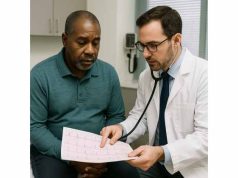
Acquired cardiomyopathy refers to a group of heart muscle diseases that develop during a person’s life—rather than being inherited—leading to the heart’s reduced ability to pump blood efficiently. These conditions can be triggered by infections, toxins, metabolic disorders, autoimmune diseases, and other environmental factors. Acquired cardiomyopathy is a significant cause of heart failure, arrhythmias, and sudden cardiac death worldwide. Understanding its root causes, recognizing symptoms early, and pursuing effective treatment can dramatically improve outcomes and quality of life for affected individuals.
Table of Contents
- Comprehensive Overview of Acquired Cardiomyopathy
- Causes and Risk Factors Behind Acquired Cardiomyopathy
- Symptom Recognition and Diagnostic Steps
- Modern Treatment Options and Management Strategies
- Frequently Asked Questions
Comprehensive Overview of Acquired Cardiomyopathy
Acquired cardiomyopathy is not a single disease, but a collection of conditions in which the structure and function of the heart muscle (myocardium) deteriorate due to factors encountered during life. Unlike genetic or congenital cardiomyopathies, which are present at birth or inherited, acquired forms develop after exposure to infections, toxins, or systemic illnesses.
The most common types of acquired cardiomyopathy include:
- Dilated cardiomyopathy (DCM): The heart chambers enlarge and lose contractile strength, often leading to heart failure.
- Restrictive cardiomyopathy: The heart muscle becomes stiff, restricting its ability to fill properly.
- Inflammatory cardiomyopathies (e.g., myocarditis): Infection or inflammation damages the myocardium.
- Toxic cardiomyopathies: Caused by substances like alcohol, chemotherapy, or recreational drugs.
Acquired cardiomyopathy may be reversible in its early stages if the underlying cause is addressed. However, if left untreated, it can progress to chronic heart failure, arrhythmias, and even sudden cardiac arrest.
Key points about acquired cardiomyopathy:
- Can develop at any age, but is more common in adults.
- Early symptoms can be subtle or mistaken for other conditions.
- Risk factors include infections, chronic diseases, certain medications, lifestyle habits, and autoimmune disorders.
- Early intervention and lifestyle modifications can significantly improve long-term outcomes.
Let’s explore how and why acquired cardiomyopathy develops, who’s at risk, and what can be done to prevent or manage this serious heart condition.
Causes and Risk Factors Behind Acquired Cardiomyopathy
Acquired cardiomyopathy results from direct or indirect damage to the heart muscle due to a variety of environmental, infectious, metabolic, and toxic factors. Identifying these causes is crucial, as treating or removing the trigger may halt or reverse heart damage in many cases.
Major Causes of Acquired Cardiomyopathy
- Infectious Myocarditis
- Viral Infections: Most commonly Coxsackievirus, adenovirus, and parvovirus B19.
- Bacterial Infections: Such as Lyme disease, diphtheria, or sepsis.
- Other Pathogens: Fungi, parasites (e.g., Chagas disease).
- Toxins and Drugs
- Alcohol abuse: Chronic heavy drinking is a leading cause of dilated cardiomyopathy.
- Chemotherapy drugs: Doxorubicin, cyclophosphamide, and others can be cardiotoxic.
- Recreational drugs: Cocaine, amphetamines, and anabolic steroids can injure the myocardium.
- Certain prescription medications: Antiretrovirals, antipsychotics, or antiarrhythmic agents in rare cases.
- Metabolic and Endocrine Disorders
- Thyroid disease: Both overactive and underactive thyroid can impair heart function.
- Diabetes mellitus: High blood sugar can damage blood vessels and the heart muscle.
- Nutritional deficiencies: Severe lack of selenium, thiamine (beriberi), or carnitine.
- Autoimmune and Inflammatory Diseases
- Systemic lupus erythematosus, rheumatoid arthritis: Chronic inflammation may involve the heart.
- Sarcoidosis: Granulomas can infiltrate the heart muscle, affecting its function.
- Physical Stress and Trauma
- Takotsubo (stress-induced) cardiomyopathy: Extreme physical or emotional stress triggers transient heart dysfunction.
- Radiation therapy to the chest: Used in cancer treatment and may injure heart tissue.
- Peripartum Cardiomyopathy
- Occurs in late pregnancy or shortly after delivery, typically in women with no previous heart problems.
Common Risk Factors for Acquired Cardiomyopathy
- Heavy or long-term alcohol use
- Recent or chronic viral/bacterial infections
- Chemotherapy or chest radiation
- Drug abuse (stimulants, steroids, cocaine)
- Thyroid or metabolic disorders
- Autoimmune diseases
- Obesity and uncontrolled diabetes
- Poor nutrition or malabsorption disorders
- High levels of psychological or physical stress
Complications and Effects of Acquired Cardiomyopathy
- Heart failure: Reduced pumping function leading to fluid overload, fatigue, and shortness of breath.
- Arrhythmias: Irregular heartbeats, including atrial fibrillation, ventricular tachycardia, or sudden cardiac arrest.
- Blood clots: Poor heart function may lead to stagnant blood and increased risk of embolism or stroke.
- Cardiogenic shock: A severe drop in blood pressure and organ perfusion.
Practical prevention tips:
- Avoid excessive alcohol and recreational drug use.
- Seek medical care for persistent infections or chest pain.
- Manage chronic illnesses like diabetes and thyroid disease.
- Ask your doctor about cardiac monitoring if you need chemotherapy or chest radiation.
Understanding your risk profile and early warning signs is the first step in protecting your heart from acquired cardiomyopathy.
Symptom Recognition and Diagnostic Steps
Symptoms of acquired cardiomyopathy can be subtle at first, but as heart function declines, signs of heart failure and arrhythmias often become more prominent. Early recognition allows for faster intervention and better outcomes.
Common Symptoms of Acquired Cardiomyopathy
- Shortness of breath (dyspnea): Especially during activity or when lying down.
- Fatigue and weakness: Reduced cardiac output leads to tiredness and poor exercise tolerance.
- Swelling (edema): In the legs, ankles, feet, or abdomen due to fluid buildup.
- Palpitations: Sensation of skipped, fluttering, or pounding heartbeats.
- Chest discomfort or pain: Especially with exertion.
- Cough or wheezing: From fluid backing up into the lungs.
- Sudden weight gain: From rapid fluid retention.
- Dizziness or fainting: May indicate arrhythmias or severe heart dysfunction.
In advanced cases:
Bluish tint to lips or fingers (cyanosis), severe breathlessness at rest, confusion, or signs of shock (cold, clammy skin, very low blood pressure).
Recognizing When to Seek Medical Attention
If you or a loved one develops new or worsening shortness of breath, chest pain, fainting, severe swelling, or palpitations, seek medical care immediately.
Diagnostic Approach for Acquired Cardiomyopathy
- Detailed Medical History and Physical Examination
- Explore recent infections, toxin exposures, medication use, family history, and symptoms.
- Electrocardiogram (ECG/EKG)
- Checks for abnormal heart rhythms, conduction delays, or evidence of old heart damage.
- Chest X-ray
- Assesses heart size and looks for fluid in the lungs.
- Echocardiogram (Heart Ultrasound)
- The most important noninvasive test. Evaluates heart structure, chamber size, function, and valve performance. Key for identifying types of cardiomyopathy.
- Blood Tests
- Check for signs of infection (white blood cells, C-reactive protein), markers of heart damage (troponin, BNP/NT-proBNP), thyroid and metabolic panels, nutritional deficiencies, and autoantibodies.
- Cardiac MRI or CT Scan
- Provides detailed images of heart muscle and helps identify inflammation, scarring, or infiltrative diseases.
- Coronary Angiography
- Assesses for blocked arteries, especially if ischemic heart disease is suspected.
- Endomyocardial Biopsy
- Rarely, a tiny tissue sample is taken from the heart muscle for microscopic analysis—usually for unexplained or rapidly progressive cases.
Practical diagnostic advice:
- Bring a list of all medications, supplements, and recent illnesses to your doctor’s visit.
- Keep track of your symptoms, weight, and activity tolerance daily if you have or are at risk for heart failure.
- Discuss the pros and cons of each test with your healthcare team.
Early and accurate diagnosis is crucial for selecting the right therapy and improving long-term outcomes.
Modern Treatment Options and Management Strategies
Treatment of acquired cardiomyopathy focuses on addressing the underlying cause, relieving symptoms, and preventing or managing complications like heart failure or dangerous arrhythmias. With advances in medication, device therapy, and lifestyle interventions, many people can lead active, fulfilling lives.
Immediate and Supportive Management
- Hospitalization:
For severe heart failure, shock, or life-threatening arrhythmias. - Oxygen and breathing support:
Supplemental oxygen or ventilation if needed. - Fluid and electrolyte management:
Intravenous diuretics, monitoring for imbalances.
Targeting the Underlying Cause
- Treat infections:
Appropriate antibiotics, antivirals, or antifungals for myocarditis. - Withdraw or replace toxins/medications:
Stopping alcohol, harmful drugs, or adjusting chemotherapy. - Correct nutritional deficiencies:
Replenish thiamine, selenium, or carnitine as needed. - Manage metabolic or endocrine disorders:
Thyroid hormone replacement or diabetes management. - Suppress autoimmune disease:
Steroids or immunosuppressants for inflammatory cardiomyopathies.
Medical Therapies for Heart Failure
- ACE inhibitors or ARBs:
Help relax blood vessels and lower cardiac workload. - Beta-blockers:
Slow the heart, reduce arrhythmias, and improve survival. - Diuretics:
Remove excess fluid and reduce swelling. - Aldosterone antagonists:
Further lower fluid retention and improve outcomes. - SGLT2 inhibitors:
Newer diabetes drugs that also help heart failure. - Ivabradine, digoxin:
Sometimes used for persistent symptoms or rhythm control.
Device and Advanced Therapies
- Implantable cardioverter-defibrillator (ICD):
Prevents sudden death in patients at risk of fatal arrhythmias. - Cardiac resynchronization therapy (CRT):
Biventricular pacemaker for those with electrical conduction delays. - Left ventricular assist devices (LVAD):
Mechanical pumps for severe, end-stage heart failure. - Heart transplantation:
Last-resort for those who do not respond to other treatments.
Lifestyle and Self-Care Strategies
- Low-sodium diet:
Helps control blood pressure and fluid retention. - Daily weight monitoring:
Early detection of fluid overload. - Regular exercise:
Supervised cardiac rehab to improve stamina and quality of life. - Limit alcohol and avoid illicit drugs:
Especially critical if these triggered the condition. - Manage stress:
Mindfulness, counseling, and support groups.
Long-Term Follow-Up
- Regular clinic visits:
Ongoing medication adjustments, lab monitoring, and imaging. - Vaccinations:
Influenza and pneumonia vaccines help prevent respiratory complications. - Psychosocial support:
Mental health care and family counseling if needed.
Tips for Patients and Families
- Create a medication schedule and stick to it—missing doses can lead to rapid worsening.
- Know the warning signs of heart failure and when to seek urgent care (e.g., rapid weight gain, severe shortness of breath, chest pain, fainting).
- Carry an up-to-date list of your medications and medical history at all times.
- Stay connected with your heart care team—regular follow-up is essential.
With advances in therapy and a collaborative approach, most people with acquired cardiomyopathy can lead longer, more active lives than ever before.
Frequently Asked Questions
What is acquired cardiomyopathy?
Acquired cardiomyopathy is a disease of the heart muscle that develops later in life due to infections, toxins, chronic diseases, or other non-inherited factors, leading to weakened heart function and sometimes heart failure.
What causes acquired cardiomyopathy?
Causes include viral or bacterial infections, chronic alcohol use, certain medications (like chemotherapy), metabolic disorders (thyroid or diabetes), autoimmune diseases, and nutritional deficiencies.
What are common symptoms of acquired cardiomyopathy?
Symptoms include shortness of breath, swelling in the legs, fatigue, palpitations, chest discomfort, cough, and in severe cases, fainting or bluish skin.
How is acquired cardiomyopathy diagnosed?
Diagnosis relies on medical history, physical exam, echocardiogram, blood tests, ECG, chest X-ray, cardiac MRI, and sometimes biopsy to identify heart muscle damage and underlying causes.
Is acquired cardiomyopathy reversible?
Some forms are reversible if the cause is found and treated early—such as stopping alcohol, treating infections, or correcting metabolic issues. Chronic forms may require lifelong management.
How is acquired cardiomyopathy treated?
Treatment includes medication for heart failure, correcting the underlying cause, lifestyle changes, devices like defibrillators or pacemakers, and in some cases, heart transplantation.
Can acquired cardiomyopathy be prevented?
You can lower your risk by avoiding alcohol and drug abuse, managing infections and chronic illnesses, getting recommended vaccines, and seeking early care for heart symptoms.
What is the prognosis for acquired cardiomyopathy?
Prognosis varies. Many recover fully if the cause is reversible. Others may live well for years with heart failure therapy. Early diagnosis and good self-care improve outcomes.
Disclaimer:
This article is for educational purposes only and is not intended as a substitute for professional medical advice, diagnosis, or treatment. Always consult your healthcare provider regarding any medical concerns or before starting or changing treatment for acquired cardiomyopathy.
If you found this information helpful, please share it on Facebook, X (formerly Twitter), or your favorite social platform. By sharing, you support our mission.










